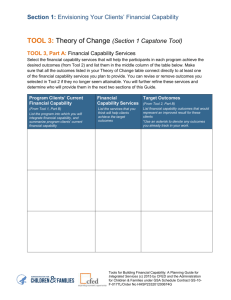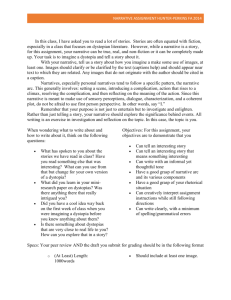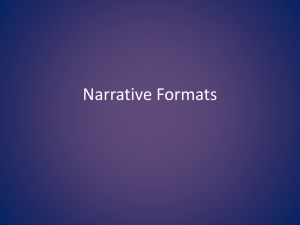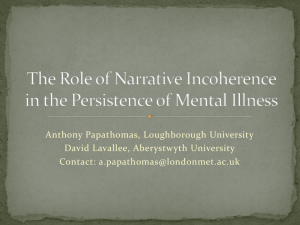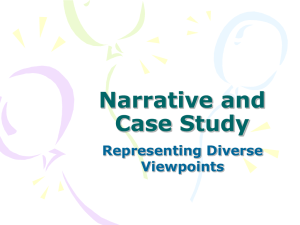MARKERS OF SALIENCE IN NARRATIVE TEXTS
advertisement
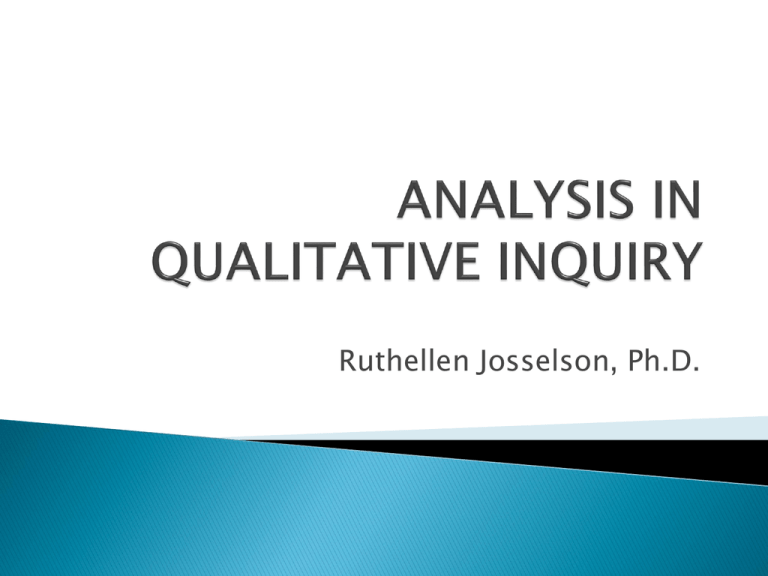
Ruthellen Josselson, Ph.D. “There is no method capable of being learned and systematically applied so that it leads to the goal. The scientist has to worm general principles out of nature by perceiving in comprehensive complexes of empirical facts certain general features which permit of precise formulation.” ---Albert Einstein DISCOVERY prediction (whether, to what extent in regard to difference) vs. meanings(process and causality) "an interpretive science in search of meaning not an experimental science in search of lawas" (Geertz, 1973, p.5) "man is an animal suspended in webs of significance he himself has spun" Big Q question – the conceptual context Little Q question – near to experience INDUCTION ABDUCTION What others The “method” have seen: – how you will The literature inquire review and conceptual context What you see – what the texts say The interpretation: What you make of it all. HOLISTIC – CONTENT HOLISTIC-FORM CATEGORICAL CATEGORICAL–CONTENT FORM From Five Ways of Doing Qualitative Analysis PHENOMENOLOGICAL ANALYSIS-Fred Wertz GROUNDED THEORY-Kathy Charmaz DISCOURSE ANALYSIS -Linda McMullen NARRATIVE ANALYSIS- Ruthellen Josselson INTUITIVE INQUIRY-Rosemarie Anderson 1) Read for the plot a) Attend to what is happening: Where are we? What are the stories being told? b) Attend to repeated images and metaphors c) Attend to dominant themes d) Note contradictions and absences 2) What are the multiple contexts in which these stories are embedded? 3) The listener’s/reader’s response to the interview a)Identify your own thoughts and feelings What are your associations to the narrative? What is your emotional response to the person and interview? b)What is your social location in relation to the participant? c) How might your response affect your understanding of the person and the stories being told? How does your response help you understand the narrative? ABSTRACT – summary of the story to come ORIENTATION – introduces person, place, time COMPLICATING ACTION – what happened EVALUATION – what is significant about the story; how it is to be understood RESOLUTION/CODA - return to the present Based on Alexander, I. (1990). Personology: Method and Content in Personality Assessment and Psychobiography. Durham, N.C.: Duke University Press. Primacy: What comes first has a particular importance because it came first to the mind of the narrator and introduces and frames the narrative. Frequency That which is repeated must have some particular meaning. Incompletion An obvious form of incompletion occurs when an expository sequence begins, follows a course, but ends before closure is reached. Or, there can be discontinuities in the narrative even when closure is reached. Uniqueness This may be pointed out by the participant as something unusual. More subtle are the signs of uniqueness that arise from either differences in expression from those commonly held in the general language, or more importantly, clear departures from the usual language expressed by the subject. Negation: Pay attention to narration that declare what is NOT or what the participant did NOT think or feel. The idea being negated still comes from the participant and we can wonder what is being negated and why. Omission We might think about what is being left out of the narrative and why this might be. Ideally, this would be inquired about at the time of interview, but it can still be considered on analysis. Emphasis: Something is called to our attention deliberately by the teller, e.g., “I want you to know that . . .,” or “A critical event in my life was . . .,” or other obvious forms of accent or underlining.” Error: Slips of the tongue or distortions may indicate important, hidden motives. Listening/reading/ interpretive communities: Read within listening communities of multiple listeners – exploring the different connections, resonances, and interpretations that each listener naturally brings to the analytic process.





